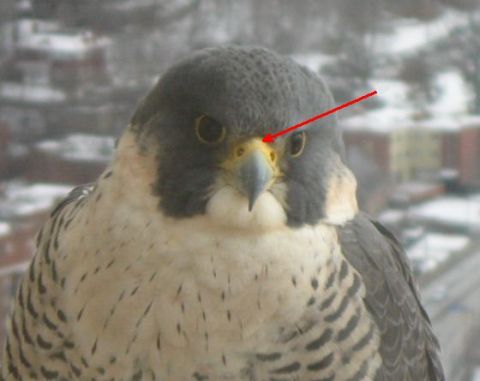
I hated to mark up this picture of Dorothy but today’s anatomy lesson is about a body part that’s a prominent feature on peregrine falcons.
The red arrow is pointing to the cere, a soft fleshy area found at the top of the beak on several kinds of birds including hawks, doves and parrots.
On pigeons, the cere looks like a lump but on raptors it’s often dramatic and changes color as the bird matures. Immature bald eagles and peregrine falcons have gray ceres; the adults have yellow.
If you look closely at Dorothy’s cere, you’ll see two holes for her nostrils or nares. Peregrine falcons have specially adapted nares so they can breathe as they dive to capture prey. While in a stoop, air rushes past their beaks as fast as they are traveling – up to 200 mph. This air pressure on typical nostrils would make it impossible to breathe so peregrines have small cones called tubercles inside their nostrils to break up the wind.
Jet engines have a similar structure called an inlet cone. My thanks go to Dick Rhoton for alerting me to this similarity which he found in the latest issue of the Aircraft Owners and Pilots Association (AOPA) magazine.
Pretty cool, huh? And a very beautiful feature on peregrines’ faces.
(photo of Dorothy, the adult female peregrine at the University of Pittsburgh, by Pat Szczepanski. Photo altered to illustrate the cere.)
What a great picture of Dorothy, and a very interesting lesson too. Thanks for the information you provide.
Here’s how I learned about jet engine inlet cones. This is the message Dick Rhoton sent me on Dec 24:
“Since ‘peregine discussions’ are sleeping this winter, I am passing this on to you to post when appropriate. I am a pilot and plane owner and just found the following question (and answer) posed in the latest issue of the AOPA magazine.
Question: “Clocked at over 200 mph, the peregrine falcon probably is the worlds fastest bird. How does it breathe at such speed and the ram air pressure without damaging its lungs?
Answer: There is a small protruding cone in the openings of the peregrine’s nostrils that is similar in design and function to the inlet cone of a jet engine. These cones, called tubercles reduce air pressure entering the nostrils.
dick rhoton”
I am just always so blown away when I read about peregrines going 200 mph. It is so hard to realize any bird could dive that fast. Watched a video from National Geographic where a peregrine named Frightful was clocked going 242mph. Just unbelievable. Last year was my first year watching and learning about the falcons. Am looking forward to it again this year.
Thank you Patsy! for an opportune moment to interject something I’ve been itching to do for a month! My librarian-sister loaned me a wonderful book originally published in 1959, and Winner of a Newbery Honor that year. It’s titled “My Side of the Mountain” and is the story of a boy who runs away from NYC and sets up an independent, camping life in the Catskills. The reason it fits is that he scales a cliffside to steal a “duck hawk” aka peregrine nestling, which he names Frightful, because he had such a frightful time capturing her. Do you think Nat’l Geographic read the book?
He trains her, with the help of his and the town librarian’s research. (Get the connection to my sister?) She becomes his major source of small game, such as rabbits, and his ears to intrusions he can’t hear yet. There are 2 sequels, Jeanne says, and I’ll look for them later! I don’t know if they’re still in print. Her copy is a republication from 1988. The jacket says it was made into a “major motion picture”. The author is Jean Craighead George, and the ISBN#–for those wannabe librarians out there–is 0-525-44392-4.
Anne